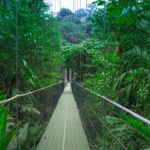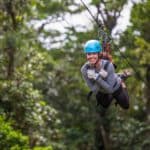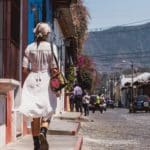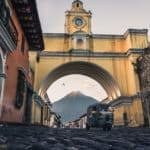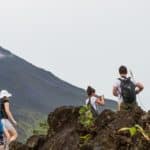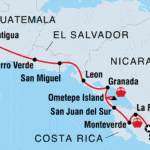Real Guatemala to Costa Rica
From the Guatemalan highlands to the cloud forests of Costa Rica (and all the surf spots in between), you’ll join a new group of soon-to-be friends and roll through four Central American countries for a taste of this diverse region. Discover tropical forests alive with jungle melodies, vast freshwater lakes and active volcanoes – this wildlife-rich pocket of Central America is ready to be explored. Turn your eyes to a volcanic crater in Cerro Verde, spot colourful birds on the facades of Granada, stand in the shadow of the mighty Arenal Volcano and search for sloths among the canopy of Monteverde Cloud Forest. This trip through Guatemala, El Salvador, Nicaragua and Costa Rica is perfect for those who like their adventures 'la forma natural'.
17 days, from
$1,255
per person
GROUP SIZE
ACTIVITY LEVEL
Details
Countries Visited:
Costa Rica
El Salvador
Guatemala
Nicaragua
Accommodation: Hotel (12 nights), Camping (2 nights), Multishare Hostel (2 nights)
Transportation: Private vehicle , Public bus , Local bus , Taxi , Shared boat , Ferry
Included Meals:
- 1 breakfasts
- 2 dinners
Group size: Minimum 1, Max 16
Minimum Age: 18
Oh, Central America, what a land. Get a taste of four different countries on an epic Latin adventure that takes in the sights and offers a whole heap of optional activities too.
Cerro Verde is waiting to be explored. Enjoy a full day at leisure in one of El Salvador’s most beautiful national parks – get up close and personal at a volcano crater or take the plunge in a pristine lake. The choice is yours!
Island life doesn’t get much better than Ometepe in Nicaragua – volcanoes, wildlife-rich rainforest, stunning beaches, ancient rock carvings, and a massive lake are all on your plate.
Central America likes to keep you on your toes – hike, cycle or zip-line through the steamy cloud forests of Monteverde in Costa Rica and commune with nature in one of the world’s most incredible landscapes.
Costa Rica's famous Arenal Volcano in La Fortuna is unbe-lava-ble. Go with the flow and let off some stream with hikes, waterfalls, watersports, and hot springs in the shadow of this giant.
Itinerary
Bienvenidos! Welcome to Guatemala. There are no planned activities today until your important welcome meeting at 6 pm. If you arrive early, Antigua has so much to offer, from its vibrant colonial-style buildings and curved archways, all the way out to the puffing volcanoes of Pacaya, Agua and Jumaytepeque. The number one stop for any chocoholic should be the ChocoMuseo, where you’ll get a history lesson and, more excitingly, participate in a chocolate-making workshop. After the meeting, take an orientation walk around the city with your leader and acquaint yourself with the cobblestone streets and colonial-era plaza. In 1773, the city of Antigua was destroyed by an earthquake, but many of the colonial buildings have been restored. For dinner tonight, perhaps sample a tamale, a local dish served in corn husk, or some pepián, a rich, meaty stew, then surely it’s time for a mojito with your new friends!
Rise and Shine! Today is an early start as you journey across the Guatemalan border to your next destination, Cerro Verde, El Salvador (approximately 5 hours). From rolling hills to rolling R’s, watch the world go by from the comfort of your private vehicle as you travel through lush volcanic landscape and endless mountain terrain all while learning the local lingo from your leader in an informal Spanish lesson. Arrive in Cerro Verde and enjoy the rest of the day at leisure.
Today is about fueling up in the local style and then getting outdoors! El Salvador is home to Papusas, a type of flatbread made from cornmeal and often stuffed with delicious fillings like cheese, chicharrón (fried pork) or refried beans. Visit a local street vendor and watch a papusa making demonstration, then try some of course! Afterwards, opt to visit Santa Ana’s Volcano crater for some more spectacular views of Lake Coatepeque, Juayua and Izalco Volcano. Alternatively, instead of admiring its view from the volcano crater, why not take a dip in Lake Coatepeque! There are many ways to keep busy in one of El Salvador's most beautiful national parks.
Continuing south by private vehicle today, pass through the capital of San Salvador on your way to San Miguel (approximately 3-4 hours). Resting in the shadows of Chaparrastique, an active volcano that sets the backdrop to this vibrant town, San Miguel has rebuilt itself into one of the largest and most populated cities in the country since facing a severe earthquake in 1917.
Say a quick hola and adios to Honduras as you cross through two borders to reach ‘the land of lakes and volcanoes’, Nicaragua (or Nica as it’s known as locally). The 6-hour drive (plus stops) will be well worth the ride as you’re welcomed into the charming, artsy and sophisticated city of Leon. Why not refuel after your journey with some traditional Nicaraguan dishes, Gallo Pinto, with its hearty combination of rice and beans, is considered a national symbol – alternatively, perhaps try out some of your new Spanish skills and order a Quesillo, a cheesy treat made of corn tortillas, pickled onion and sour cream. Once the capital of Nicaragua, Leon has long been the heart and soul of the country’s political movements, which is demonstrated through the city’s colourful street murals – an artistic reflection of fallen heroes and revolutionary icons. Home to one of the oldest universities in Central America, Leon is considered a ‘college town’ and is known for its youthful, fun atmosphere and energetic nightlife. This evening, why not head out with the group for some bachata or salsa dancing!
This morning join your leader on an orientation walk around Leon. Then take some time to explore on your own, perhaps check out the Basílica de la Asunción – Central Americas largest cathedral – or stop by the Museo Histórico de la Revolución for an insight the revolutionaries who fought hard for the freedom of their country. Alternatively, you might like to go volcano sandboarding! (This is the only place in the world that you can do it). Afterwards, if you’re feeling peckish, why not fill up on the traditional breakfast of scrambled eggs and gallo pinto before jumping on a local bus this afternoon to Granada. First, take a taxi from the hotel to the bus station, next board a local bus bound for Managua that will depart when it's full and takes around 2-3 hours depending on the amount of stops it needs to make and the complexity of onloading and offloading the passenger’s luggage. There will be about a 30-45-minute transit in Managua before taking the next public bus to Granada with a duration of approximately 1.5 hrs, and finally taking a 20-minute taxi ride to the hotel. Founded in 1524, Granada is the oldest city in Nicaragua and home to iconic Moorish and Andalusian landmarks that have survived repeated pirate invasions. Draped in colourful colonial architecture and oozing aesthetic charm, this enchanting city is set on the banks of Lake Nicaragua and is surrounded by active volcanoes.
Rise and shine! This morning we’ll enjoy breakfast together at Cafe de las Sonrisas, a café run entirely by deaf people. The café's owner is aiming to bridge the gap and inspire other business owners to employ local people living with disabilities. Then you are free to explore Granada, one of Central America’s least spoiled colonial towns. Perhaps you’d like to take a guided tour of the city, bargain hard in the markets, or wander the cobblestone streets, snapping photos of the colourful buildings. If you’re an adventure enthusiast, opt to hire a kayak and paddle around the islets of lake Nicaragua, rent a bicycle and ride to Laguna De Apoyo (a 200 year old lake set into a lush forest crater), or hike through the lush flora and fauna along the Mombacho volcano crater trail. For a cultural insight into the heritage of the Nicaraguan people, the city of Masaya aka ‘City of the Flowers’ offers a mixture of folkloric entertainment, from marimba music to street theatre. If you’re looking to purchase some traditional handicrafts, then you’ll also find ‘Mercado de las Artesanías’ – a craft market offering handmade souvenirs reflective of the Masaya area. After a day of exploration, why not enjoy an evening along Calle la Calzada – grab a drink at one of the many outdoor bars and watch the wandering performers, from mariachis to break dancers, bring the street to life.
This morning, travel by local bus to Rivas where you'll transfer to San Jorge ferry port by taxi (approximately 2.5 hours). Catch a 1-hour ferry across Lake Nicaragua (the largest in Central America and the tenth largest freshwater lake in the world) to the island of Ometepe, and head to your hotel. Hourglass-shaped Ometepe Island was formed by two volcanoes rising out of Lake Nicaragua (Ometepe literally means two volcanoes in the Nahuatl language) and the deep jungle is home to exotic wildlife such as monkeys and parrots. A great experience is to sit on the shore and watch fishermen return from a long day on the water with their catch.
Take advantage of a free day to discover the island. Perhaps take a hike up to the summit of either the Concepcion or Maderas volcanoes, but be warned, at 1700 and 1394 metres above sea level respectively, these are serious volcanoes and the treks are no walk in the park. You might prefer to splash around in the natural springs, soak up the sun on the shore or check out the island's petroglyphs (ancient rock carvings). If you like watermelon, coffee, banana and citrus fruits then Ometepe is the place for you, plantations abound, you’ll have loads of delicious fresh food to feast on. In the evening, head to Los Ramos, an indigenous community situated right in the middle of the island’s volcanos, for a cooking class. Learn traditional techniques used to make Nicaraguan dishes like nacatamales (a dough-based snack often filled with meat and steamed in banana leaves) before sitting down to a meal together.
Today you’ll take the two-hour journey (by ferry and public bus) to San Juan del Sur, a laidback surf town on Nicaragua’s south-west coast. Though the beach that lines the town’s horseshoe bay itself isn’t particularly great for swimming, you don’t need to travel far to find beautiful golden beaches with year-round waves. Go on an orientation walk with your leader and then enjoy free time to acquaint yourself with this fun little town.
Enjoy a free day exploring San Juan del Sur’s colourful coastal scenery. If you’re feeling active, San Juan del Sur has plenty to offer. You might like to rent a surfboard and spend the day riding the waves at nearby beaches like Playa Maderas or Playa Marsella, alternatively, head south to La Flor beach reserve, where it’s possible to see olive ridley, hawksbill, leatherback and green sea turtles nesting between July and November. A huge statue of Christ (the largest in Central America) sits atop a cliff above the bay – why not hike to the top for spectacular views of the town and Pacific. In the evening, the city boasts a variety of greats bars and restaurants where you can share a meal with the group.
Say Adios to Nicaragua and continue your journey south to Costa Rica. Take a 1-hour bus to the border and then travel by private vehicle to Monteverde (approximately 5 hours). Monteverde was founded as an agricultural community in 1951 by a group of North American Quakers, these environmentally aware settlers also established a small wildlife sanctuary, which has since grown into the internationally renowned Monteverde Cloud Forest Biological Preserve. Cloud forests are similar to rainforests, but instead, draw their water from a semi-permanent cloud covering the region. Constant mist in the forest makes it feel a bit like a nightclub! But with less bass and more fresh air, this is truly a nature lover's paradise. More than 2000 plant species, 320 bird species and 100 mammal species call Montverde home – be sure to keep an eye out for the resplendent quetzal, one of the most elusive birds in the world.
Today you have a full free day to discover the reserve and experience the mystical and fragile environment here. Monteverde is not for the faint-hearted, so bring your sense of adventure, a solid pair of shoes, and have a little fun with the giddy heights. Perhaps take a hike through the cloud forest, check out the area by mountain bike, or fly over the canopy on a zip-line tour. Another way to see the forest from above is to take a tour along a series of suspension bridges 40 metres up above the jungle. You can explore the park on your own or arrange for a local guide to accompany you. The guides are very knowledgeable and happy to engage in conversation. To see some guaranteed wildlife up close, visit the butterfly and insect gardens or the serpentarium – there are also several cooperatives worth visiting in the local communities.
Continue your journey through Costa Rica and take the scenic route to La Fortuna (approximately 4-5 hours). Travel by shared minibus to Lake Arenal, which you'll then cross by boat. On a clear day you'll see fantastic views of the surrounding area. On the other side of the lake, re-board the minibus and continue on to your destination. La Fortuna is a small town situated just a few minutes from Costa Rica's most famous volcano, the majestic Arenal. While you're here, make sure you take some photos of the volcano reflected spectacularly in the lake. Get a good rest tonight, as tomorrow you’ve got a free day to take advantage of all the active activities on offer.
There are plenty of optional activities to take part in today, so when you get home, this isn’t the place to say you sat around! Perhaps take a guided nature hike through the lush forest surrounding Arenal Volcano, keeping an eye out for rare plants and animals, or opt to see the forest from a series of hanging bridges. Check out the 70-metre high La Fortuna waterfall, or get wet with some water sports on the lake, such as stand-up paddle boarding. The volcano’s inner workings also mean that the area is home to several thermal hot springs, an ideal way to relax in the middle of nature. Alternatively, a boat safari down the Celeste River offers the opportunity to see lizards, crocodiles and tropical birds in their natural habitat.
Take a local bus to Costa Rica's capital, San Jose (approximately 5 hours). Situated in the fertile Central Valley and home to over half the country's population, San Jose is filled with lively markets, intriguing museums and a dynamic atmosphere. A good place to start your exploration is the main plaza. Artisan booths are common here, so you never know when an art fair will pop up. The Gold Museum has an amazing collection of indigenous gold art or if you're in the mood for a bit of shopping, head to the outdoor market in the Plaza de la Cultura or the city's Central Market, where you can buy anything from handicrafts to seafood. Then it's maybe time for a final farewell dinner (or margarita) with your new travel buds and say muchas gracias to your Central American journey.
Today your Central American adventure comes to an end, there are no activities planned. As there's a lot to see and do in and around San Jose, we recommend staying on for a few days to make the most of the city. If you'd like to extend your visit and need further accommodation, our reservations team would be happy to assist (subject to availability). There are some great day tours you can take outside of the city, such as or Irazu Volcano.

